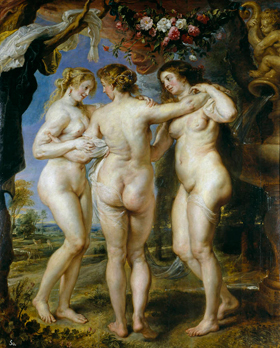/
EN
| Peter Paul Rubens The Three Graces Ca. 1635 Museo del Prado, Madrid, Spain |
|
List of sources:
http://www.museodelprado.es/de/ besuchen-sie-das-museum/ 15-meisterwerke/grundlegende- werksangaben/obra/die-drei-grazien/ |
The artist broke with the tradition of depicting women in stylized and exaggerated ways. His intention was to portray women in realistic ways showing even physical imperfections. The painting represents the three Graces (Radiance, Joy, Abundance) in realistic ways. The genitalia are omitted, and - similar to antiques sculptures – are represented by a slightly prominent pubic mound and without pubic hair. Upon closer examination is perceptible in the woman situated at the very left the discreet sign of the outer labia, that he has emphasized by the use of darker color. In the woman to the right, his intention of rendering the genitals more realistic is perceptible, plasticity is accentuated by emphasizing the pubic mound with color. In preliminary studies, i.a. Rubens' drawing of the Venus of Knidos, the pubic triangle and outer labia are depicted sculpturally.
Biography: http://de.wikipedia.org/wiki/Peter_Paul_Rubens (Translation: K. Seifter)
|



